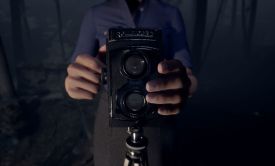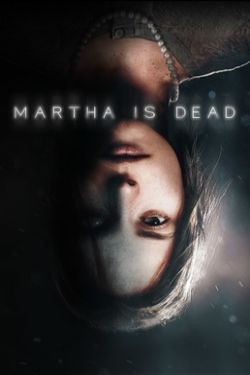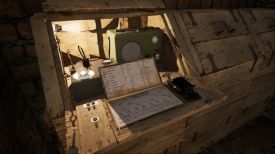|
By flotsam
Martha is Dead
LKA / Wired Productions
I have found this a rather hard
review to write.
You would think some of the easy
bits would be its general description, especially when pulled from the
publisher’s website – “a dark first-person psychological thriller, set
in 1944 Italy, that blurs the lines between reality, superstition and
the tragedy of war” and “an exploration of loss, relationships and the
psychological undertones of a dark period of history”. Pull in a few
bits from the relevant Steam page – “Martha is dead, and her twin sister
Giulia, the young daughter of a German soldier, must alone deal with the
acute trauma of loss and the fallout from her murder” and a hunt for the
truth that is “shrouded by mysterious folklore” – and there you have it.
Except you don’t. Not nearly.
The quoted descriptions that
describe the game aren’t wrong, but they tell a deficient story. Loss
and trauma and grief are present, but so is mental illness, as well as
cruelty and horribleness.
You get a better sense of what
lies ahead from the game warning:
The story of Martha Is Dead and its featured characters are a work of
fiction, the game contains potentially uncomfortable scenes and covers
topics that may distress some players. The game is recommended for an
adult audience and carries the appropriate age rating.
As an adult narrative drama, the game uses artistic interpretations that
can be visually unsettling and may cause discomfort. It explores the
complexities of the human mind, psychological trauma and self-harm.
The game is not recommended for players who may find depictions of
mature scenes containing blood, dismemberment, disfigurement of human
bodies and self-harm disturbing.
It is not the sort of
“narrative” you would expect to find underpinning most adventure games.
The warning is on the Steam page
and plays at the start of the game, after which there is a mental health
prompt, stating that if you or someone you know is struggling,
information and resources are available at safeinourworld.org/find-help.
It is repeated at the end of the game.
I went to the website:
The main goal of Safe In Our World is to create and foster worldwide
mental health awareness within the video game industry; to eliminate the
stigma surrounding mental health, to make it a natural topic of
discussion, and to promote the dialogue surrounding mental health so
people are not afraid to reach out for help if they need it.
The director, writer and lead
designer on the game is a Patron of the site, each of whom “work to
drive the conversation about mental health”.
I will come back here.
Not everything is like that
though. You can take and develop photos (indeed you will need to),
wander in the woods, consult your tarot cards. Fix and ride a bike, find
and use a range of camera accessories, and even engage in some war
related side-quests. I found the photo taking and developing overly
convoluted and the tarot divinations rather pointless, but all these
things offered an adventuring point of difference.
The setting is rural Tuscany,
and it looks excellent. Both the places and the historical context are
apparently reconstructed from real facts and places. You have freedom of
movement through a combination of mouse and keyboard, and when quietly
exploring it was a visually exciting place to be. The soundscape doesn’t
let it down either. And some of the individual game elements verge on
the inspired; the puppet imagery and their theatres is an example.
Without spoiling things, I found
the underlying narrative intriguing. All the more so having reached the
end. I have a number of ideas about what actually occurred, and it
probably warrants another play through to see what detail might support
one or another.
And yet.
I found the whole thing almost
overwhelmingly bleak.
Which somewhat surprised me. The
Road is one of my favourite novels, and it reeks bleak. So there was
something else.
Which is that I did some awful
things. Only a few but they were truly awful.
It hit me when I was engaging in
one of the puppet theatres. I knew what was going to happen and I didn’t
want to do it, yet I had to in order to make the game go on. Even though
it was far less extreme visually than other things to that point, I had
had enough and almost gave up.
The mouse interface didn’t help.
It can be both awfully fiddly and effectively immersive, depending on
how it is deployed. The latter is a mixed blessing; mimicking the action
of some of the extreme sequences accentuated their inherent violence.
I have done some fairly grisly
things in other games, mainly in first-person-shooters, and haven’t felt
the same. Perhaps it’s the ‘action’ rush that generally accompanies the
carnage, perhaps the lack of action made this one feel the most ‘real’.
The overall tone certainly accentuates their impact.
Returning to mental health, far
be it from me to tell anyone how to drive such a conversation, and I can
well accept that blunt might be necessary to break through. I wondered
whether perhaps I was supposed to feel as I did, mirroring the struggle
of the character, forcing myself to push through with her. Maybe just
the fact that I am still thinking about these things is more the point.
And yet.
While there is hope at the end,
I think loses something under the grim.
Far more mundanely.
It plays in the first person and
uses a combination of the mouse and keyboard. Spacebar will highlight
active items, and little hotspots will appear as you get closer in any
event. You often have to click and hold to activate the particular
curser. Save as you like and it will autosave as well.
Your bag once you have it is
effectively your inventory, and it includes a map, which will show where
you are and help you get to necessary locations, and has tabs for your
photo album, a list of your objectives with helpful associated
information, and a detailed conversations and reminiscences. Your camera
is in there along with all the attachments you find, as well as various
items you collect.
You can click to ‘examine’ an
item, and having the item is enough for it to be used where appropriate.
Pop up messages or icons on the bag will let you know something has been
added or achieved.
Given it was set in Italy, I
played in Italian with English subtitles, and enjoyed that element a
lot. You can choose English language if you wish
Martha is Dead won’t be for
everyone. I am not really sure it was for me. But it takes a big swing
and you will remember it.
I played on:
OS: Windows
10, 64 Bit
Processor:
Intel i7-9700K 3.7GHz
RAM: Corsair
Dominator Platinum RGB DDR4 32GB
Video card:
AMD Radeon RX 580 8192MB
GameBoomers Review Guidelines
March 2022
design copyright© 2022
GameBoomers
Group
 GB
Reviews Index GB
Reviews Index |






